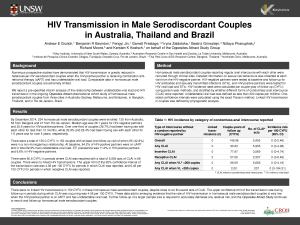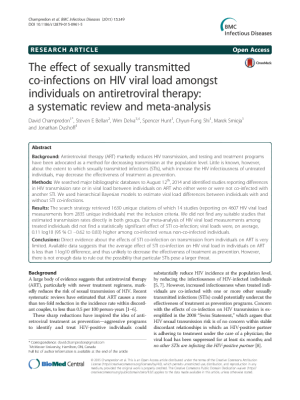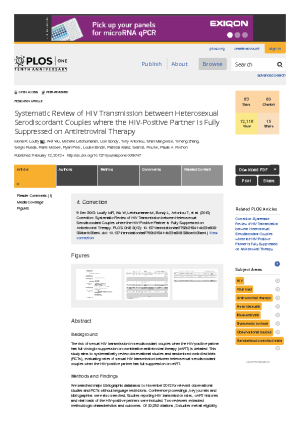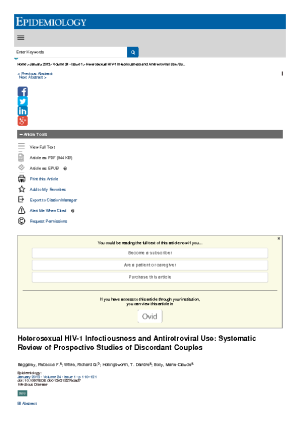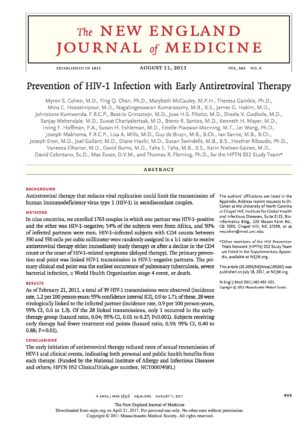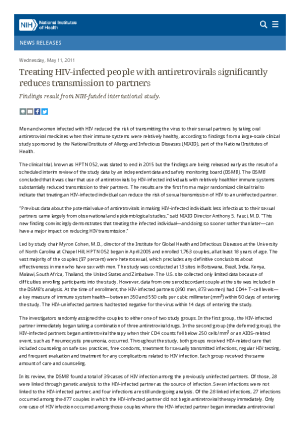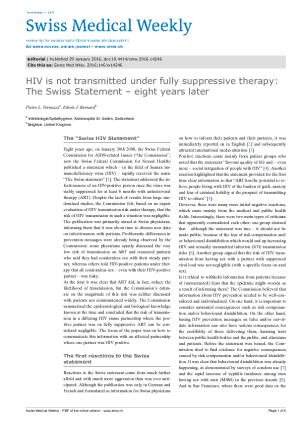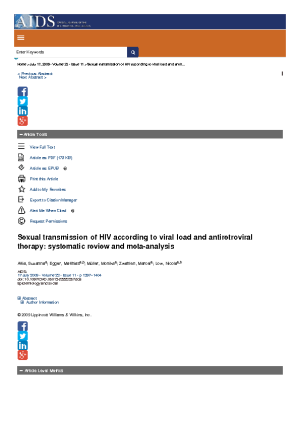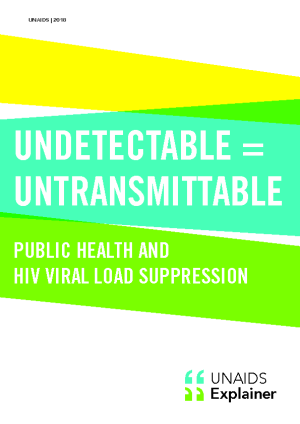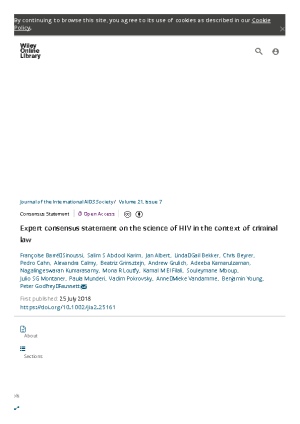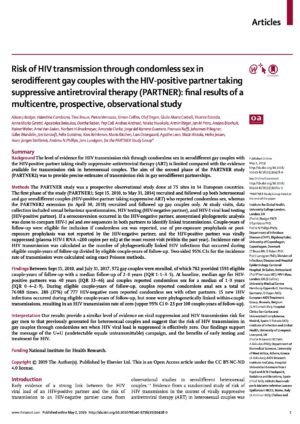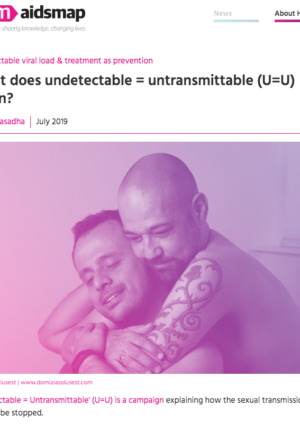Reports an interim analysis of the relationship between undetectable viral load and HIV transmission in the Opposites Attract observational cohort study of homosexual male serodiscordant couples in Australia. Finds no linked HIV transmissions in 150 ‘couple years of follow up’ among homosexual male serodiscordant couples, despite close to six thousand acts of condomless anal sex.
Transmission - Treatment and Viral load
Understanding of the effect of HIV treatment on HIV transmission risk has increased enormously over the last few years. The following studies show that successful HIV treatment suppresses the amount of HIV in a person’s blood, making HIV transmission very unlikely.
The effect of sexually transmitted co-infections on HIV viral load amongst individuals on antiretroviral therapy: a systematic review and meta-analysis
Analyses 14 studies to find evidence about the effects of STI co-infection on transmission from individuals on ART is very limited. Available data suggests the average effect of STI co-infection on HIV viral load in individuals on ART is unlikely to decrease the effectiveness of treatment as prevention. However, limited data precluded ruling out the possibility that particular STIs pose a larger threat.
Systematic Review of HIV Transmission between Heterosexual Serodiscordant Couples where the HIV-Positive Partner Is Fully Suppressed on Antiretroviral Therapy
Meta-analysis suggests minimal risk of sexual HIV transmission for heterosexual serodiscordant couples when the HIV-positive partner has full viral suppression on cART with caveats regarding information on sexual intercourse type, STIs, and condom use.
Heterosexual HIV-1 infectiousness and antiretroviral use: systematic review of prospective studies of discordant couples
Systemic review and meta-analysis of 50 studies considered HIV transmission risk between heterosexual partners. Found ART substantially reduces HIV infection risk within serodiscordant couples.
Prevention of HIV-1 Infection with Early Antiretroviral Therapy
Reports findings of OPTN 052 study based in nine countries, which found early initiation of antiretroviral therapy reduced rates of sexual transmission of HIV-1 and clinical events, indicating both personal and public health benefits from such therapy.
Treating HIV-infected people with antiretrovirals significantly reduces transmission to partners: Findings result from NIH-funded international study
Describes findings of the HPTN 052 study: that early initiation of antiretroviral therapy reduced rates of sexual transmission of HIV-1 and clinical events, indicating both personal and public health benefits from such therapy.
HIV-positive individuals not suffering from any other STD and adhering to an effective antiretroviral treatment do not transmit HIV sexually. [The Swiss Statement]
Review of existing studies to show that a person with HIV who has no other sexually transmissible infection, has adhered to antiretroviral therapy (ART) for at least 6 months to achieve completely suppressed viremia, and is monitored by an attending physician cannot pass on the virus through sexual contact.
- Alternative links
- French / Français, German / Deutsche
HIV is not transmitted under fully suppressive therapy: The Swiss Statement – eight years later
Outlines the background to the Swiss Statement, reactions to the Swiss Statement, and the fact that subsequent research has not undermined its assertions. Includes observations about its legacy, including more honest communication between patients and clinicians, and the development of official guidelines recognising the effectiveness of ART.
Sexual transmission of HIV according to viral load and antiretroviral therapy: systematic review and meta-analysis
Review and meta-analysis of 11 articles found no HIV transmission among heterosexual discordant couples when the positive patient was treated with ART and had a viral load below 400 copies (with data compatible with one transmission per 79 years).
How reliable is an undetectable viral load
Considers the reliability of viral load as a condition preventing HIV transmission. Found reliability is high with compliance taking medication the most important factor predicting reliability.
Undetectable = untransmittable — Public health and HIV viral load suppression
UNAIDS factsheet explaining how twenty years of evidence demonstrate that HIV treatment is highly effective in reducing the transmission of HIV. People living with HIV on antiretroviral therapy who have an undetectable level of HIV in their blood have a negligible risk of transmitting HIV sexually.
Expert consensus statement on the science of HIV in the context of criminal law
Twenty scientists from regions across the world developed this Expert Consensus Statement to address the use of HIV science by the criminal justice system. Description of the possibility of HIV transmission was limited to acts most often at issue in criminal cases. The authors recommend that caution be exercised when considering prosecution, and encourage governments and those working in legal and judicial systems to pay close attention to the significant advances in HIV science that have occurred over the last three decades to ensure current scientific knowledge informs application of the law in cases related to HIV.
- Alternative links
- Expertní prohlášení k vědeckým poznatkům o HIV v kontextu trestního práva ,
Risk of HIV transmission through condomless sex in serodifferent gay couples with the HIV-positive partner taking suppressive antiretroviral therapy (PARTNER): final results of a multicentre, prospective, observational study
Study findings provide conclusive evidence that the risk of HIV transmission through anal sex when HIV viral load is suppressed is effectively zero.Among the 782 serodifferent gay couples followed for almost 1600 eligible couple-years of follow-up, which included more than 76 000 reports of condomless sex, zero cases of within-couple HIV transmission were found. In the absence of ART, on the basis of the frequency and type of sex, for receptive condomless anal sex acts alone approximately 472 transmissions would have been expected. The results give equivalence of evidence for gay men as for heterosexual couples and indicate that the risk of HIV transmission when HIV viral load is suppressed is effectively zero for both anal and vaginal sex.
What does undetectable = untransmittable (U=U) mean?
Overview of U=U, explaining how effective treatment lowers the level of HIV (the viral load) in the blood to a level where sexual transmission of HIV is no longer possible. When the levels are extremely low (below 200 copies/ml of blood measured) it is referred to as an undetectable viral load. At this stage, HIV cannot be passed on sexually.
